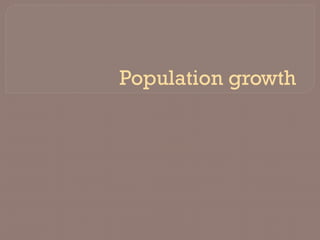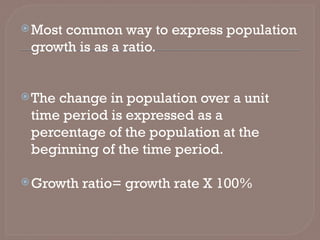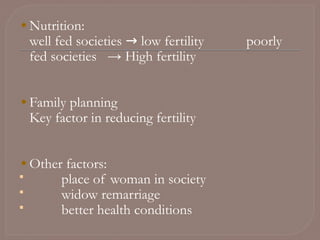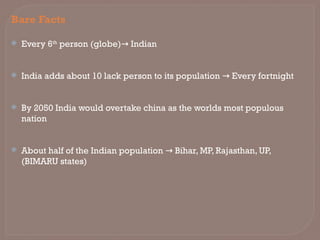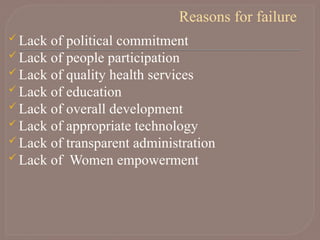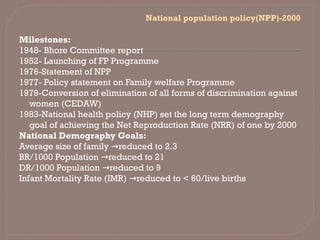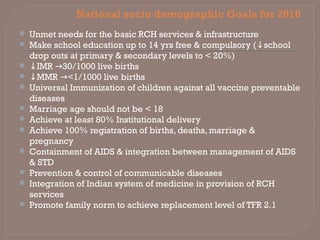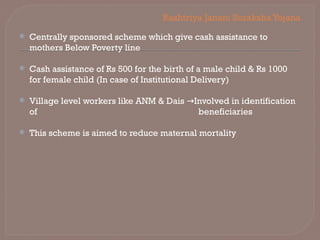Population growth (2)(1).11111111111pptx
- 2. Population growth: change in population over time, and can be quantified as the change in the number of individuals in a population using "per unit time" for measurement.
- 3. Population growth rate (PGR) is the fractional rate at which the number of individuals in a population increases. change in population over a unit time period. Growth rate= Population at the end of the period-population at beginning of period Population at the beginning of the period Growth rate = crude birth rate - crude death rate + net immigration rate, or ∆P/P = (B/P) - (D/P) + (I/P) - (E/P). P: total population, B: number of births, D: number of deaths, I : number of immigrants, and E is the number of emigrants.
- 4. Most common way to express population growth is as a ratio. The change in population over a unit time period is expressed as a percentage of the population at the beginning of the time period. Growth ratio= growth rate X 100%
- 5. A positive growth ratio (or rate) indicates that the population is increasing, while a negative growth ratio (or rate) indicates population falling. A growth ratio of zero indicates that there were the same number of people at the two times – net difference between births, deaths and migration is zero.
- 6. Globally, the growth rate of the human population has been steadily declining since peaking in 1962 and 1963 at 2.20% per annum. The world population was at its peak till 1970 where human population grew by 1.92% In 2009 the estimated annual growth rate was 1.10%.
- 7. Growth rate > 2%: Countries of the Middle East, Sub-Saharan Africa, South Asia, Southeast Asia, & Latin America
- 8. The expected no of births/ woman at current fertility rates is: For industrialized countries-1.6 For developing countries- 2.9 Least developed countries- 4.9 Global total fertility rate is 2.6 World population has been growing at 176 people/min; 10,564 people/hr; 253,542 people/day & 92,543,000 people/yr The last one hundred years have seen a rapid increase in population due to medical advances & massive increase in agricultural productivity made possible by the Green Revolution
- 9. Net Reproduction Rate(NRR): NRR >1 indicates that the population of women is increasing, NRR <1 indicates that the population of women is decreasing.
- 10. Population in India: India’s population can be divided in four distinct phases: 1901-1921 stagnant phase 1921-1951 steady growth 1951-1981 Rapid high growth 1981-2001 High growth with sure signs of slowing
- 11. Indias population 238 million in 1901 438 million in1961 846 million in 1991 Population increasing at the rate of 16 million/yr
- 12. During 1981-91, population of India increased by about 23.86% & average exponential growth rate was 2.14. There was lowering of population growth during 1991- 2001, with decadal growth rate being 21.34% & exponential growth rate being 1.93%. Though the growth rate of India's population is high, there are several other countries with higher growth rates: Bangladesh: 2.67 Pakistan: 3.44 Nepal: 2.48
- 13. Growth of population in states & union territories During decade 1981-1991, lowest annual growth rate(0.9%) were recorded by Kerala followed by TN, AP & Goa. Highest annual growth rates are observed for Nagaland, followed by Dadra & Nagar Haveli, Daman, Diu & Delhi. It is difficult to identify the factors responsible for interstate variations in growth rates because reliable data on births deaths & migration are not available.
- 14. Causes of population growth Universality of marriage: Every one gets married & participate in reproduction. Early marriage: 60% girls 16-19yrs already married. Early Puberty: Indian girls attain early puberty Low std of living: Low std of living →↑BR Low literacy: 65.8% of population- literate Female literacy- still lower Traditional habits & customs: Children gift of God Absence of FP
- 15. Contd Absence of natural checks: Famines & large scale epidemics Mass control of diseases: Smallpox, plague, cholera Advances in medical sciences: Chemotherapeutics Antibiotics & insecticides Better health facilities: PHC Impact of national health programmes Improvements in food supply International aid in several directions Development of social consciousness among masses
- 16. CAUSES OF POPULATION EXPLOSION: Widening gap between birth rate (BR) & death rate (DR) Low age at marriage Low female literacy Unfavorable religious attitude towards family planning (FP) Gender inequality & importance of male child Joint family system: less responsibility of couple to bring up their children Lack of information Lack of choice of contraceptives Side effects of contraceptives leading to distrust among people Poor services of family planning Poverty: More the no of children more working hands → Strict laws, forceful implementation of FP services: India has witnessed the effect of failure of such a policy in 1977 when forceful male fertilization Political & public movement →
- 17. Key factors in fertility decline were: Changes in government attitudes towards growth Spread of education Increased availability of contraception & Extension of services offered through family planning programmes Marked change in marriage patterns.
- 18. Effects of population growth Results in poverty. Rising global temperature. Shrinking amount of cropland per person. Decline in amount of wheat and rice grown/person. Shrinking area of tropical moist forests. Decreasing oceanic fish harvest per person. Increasing number of people dying due to various diseases. ↓Std of living, decrease life expectancy, ↓MMR Growing gap between rich and poor
- 19. EFFECTS OF POPULATION EXPLOSION 1) Living standards of people: Large no of people are homeless Majority of people Without safe drinking water → ↑ Illiteracy & more among them are women ↑ Prevalence of under weight children & malnourished women Housing & living areas over crowded Break down of transport, electricity & crime 2) Rise in crime & violence. 3) High level of un employment 4) Poverty ↑ 5) Famine
- 20. 6) Health education & research Poor health ↓ → 7)Poor sanitation services 8) Environmental degradation : Air, water, soil. 9)Deforestation & ecology modification Global warming → 10) Increased competition for survival Unhappiness →
- 21. Measures to reduce Population overgrowth Age at marriage- prior to 1951: age at marriage for girls: 13 yrs Child marriage restraint act, 1978: ↑15-18 yrs Duration of married life- 10-25% of births in 1-5 yrs of married life 50-55% of births 5-15 yrs of married life. Family planning efforts should be concentrated in first few yrs of married life
- 22. Spacing of children: when all births are postponed by 1 yr →↓GFR Education: TFR 1.5 children for illiterate women than for women with at least high school education(NHFS2) Economic status: Inverse relationship with fertility. Economic development-best contraceptive. (World population conference) –Bucharest.
- 23. Nutrition: well fed societies → low fertility poorly fed societies → High fertility Family planning Key factor in reducing fertility Other factors: place of woman in society widow remarriage better health conditions
- 24. National policies to reduce demographic gap National Family Planning Programme: India : 1st country to launch Family Planning Programme →CBR↓ 40.8(1951) to 26.4 (1998) National Health Policy, 1983: TFR of 2.1 achieved by yr 2000 TFR : 6.0(1951) → 3.3(1997) National population policy: Stable population by 2045
- 28. Introduction: Population explosion is defined as the “phenomenon of the size of a population tending to a large number in a finite interval of time.” Current population of India 113 → crores which accounts 16% of worlds population While the global population Increased threefold from 2 billion → to 6 billion Indian population Increased nearly → fivefold from 23 crores to 113 crores.
- 29. Bare Facts Every 6th person (globe) Indian → India adds about 10 lack person to its population Every fortnight → By 2050 India would overtake china as the worlds most populous nation About half of the Indian population Bihar, MP, Rajasthan, UP, → (BIMARU states)
- 30. Reasons for failure Lack of political commitment Lack of people participation Lack of quality health services Lack of education Lack of overall development Lack of appropriate technology Lack of transparent administration Lack of Women empowerment
- 31. National population policy(NPP)-2000 Milestones: 1948- Bhore Committee report 1952- Launching of FP Programme 1976-Statement of NPP 1977- Policy statement on Family welfare Programme 1979-Conversion of elimination of all forms of discrimination against women (CEDAW) 1983-National health policy (NHP) set the long term demography goal of achieving the Net Reproduction Rate (NRR) of one by 2000 National Demography Goals: Average size of family reduced to 2.3 → BR/1000 Population reduced to 21 → DR/1000 Population reduced to 9 → Infant Mortality Rate (IMR) reduced to < 60/live births →
- 32. 1986-Policy evolved & promoted slogan “movement of the people, by the people, for the people.” 1991- National Development Council appointed a committee on Population 1993- Dr MS Swami Nathan Report was submitted 1995- 4th World Conference on women in Beijing 1997- Cabinet approved the draft National Population Policy 1999- Final draft National Population Policy was approved by the parliament as “National Population Policy 2000”
- 33. Objectives Immediate: To meet the unmet need of contraception Strengthening health infrastructure Strengthening of health personnel Promote integrated services for basic health care Midterm: To Total Fertility Rate (TFR) 2 by 2010 ↓ → Long term: Stable Population by 2050
- 34. National socio demographic Goals for 2010 Unmet needs for the basic RCH services & infrastructure Make school education up to 14 yrs free & compulsory ( school ↓ drop outs at primary & secondary levels to < 20%) ↓IMR 30/1000 live births → ↓MMR <1/1000 live births → Universal Immunization of children against all vaccine preventable diseases Marriage age should not be < 18 Achieve at least 80% Institutional delivery Achieve 100% registration of births, deaths, marriage & pregnancy Containment of AIDS & integration between management of AIDS & STD Prevention & control of communicable diseases Integration of Indian system of medicine in provision of RCH services Promote family norm to achieve replacement level of TFR 2.1
- 35. Strategies Decentralized planning & Programme Implementation: 73rd & 74th Constitutional amendments act, 1992 made health, family welfare & education a responsibility of Village Panchayat raj Institutions Since 33% of elected Panchayat seats Reserved for women, → representative committee of panchayat should be formed( headed by women) to promote a gender sensitive, multisectoral agenda for population stabilization locally.
- 36. Conversion of service delivery at village levels More flexible approach Basic reproductive & child health care → through mobile clinics & counseling services Govt alone cant make for the inadequacies in healthcare infrastructure & services, hence involvement of nongovernmental sector in partnership with the government is essential One stop integrated & coordinated service at village level for basic RCH services By providing at least 2 trained birth → attendants/village It is proposed that an equipped maternity hut in each village should be set up to serve as delivery room with functioning midwifery kits & basic medication for essential obstetric aid
- 37. EMPOWERING WOMEN for Improved health & nutrition Maternal mortality is an indicator of disparity to appropriate health care & nutrition services particularly during pregnancy & child birth. Programmes for safe motherhood, universal immunization, child survival, & oral rehydration have been combined into an integrated Reproductive and child health Programme which includes promoting managements of STIs & RTIs Voluntary NGOS & private cooperative sector should actively collaborate with the government through specific commitments in basic areas of RCH
- 38. Child survival and child health Infant mortality is an sensitive indicator of human development A National Technical committee should be set up, consisting of Obstetrics, pediatrics, family health, medical research & statistics, public health professionals, clinical practitioners & govt Its main aim is to set up perinatal audit norms, developing quality improvement activities with monitoring schedules & suggestions for provision of continuing medical & nursing education to all perinatal health care providers Baby Friendly Hospitals should be extended to all hospitals, & clinics up to sub centre levels Child survival interventions Universal immunizations, control of → childhood diarrhoea, with oral rehydration therapies, management of ARI, massive doses of vitamin A & food supplements have helped to ↓IMR &MMR.
- 39. Meeting the unmet needs for family welfare services Strengthen, energize & make accountable health infrastructure → at village, sub centre &PHC for referral transportation Greater emphasis for under served population groups 1) Urban slums: Basic primary health care including RCH care needs to be provided Coordination with municipal bodies for water, sanitation & waste disposal 2)Tribal communities, hilly populations & displaced and migrant population: need special attention in terms of basic & RCH services
- 40. Adolescents: Encourage delayed age of marriage, child bearing, and education of adolescents about the risk of unprotected sex Increased participation of men in planned parent hood: Active Involvement of men FP, Supporting contraceptive use, → helping pregnant women stay healthy, arranging skilled care during delivery, helping after the baby is born & finally become responsible father Currently > 90% of the sterilizations Tubectomies & this → manifestation of gender imbalance needs to be corrected. Re popularizing vasectomies No Scalpel Vasectomy as a safe & → simple procedure.
- 41. Diverse health care provider: Private practitioners of Indigenous system of medicine →Need to be accredited & assigned with definite beneficiary groups to provide specific clinical services. Collaboration with commitment from private agencies & NGOs: Private health care has grown significantly which accounts for 75% of health care expenditures Mobilizing the private sector to serve the public through public- private Partnerships
- 42. Involvement of Indian system of medicine in the delivery of RCH services: Utilization of Indian System of Medicine & Homeopathy (ISMH) In → delivery of basic RCH services expand the pool of effective → health care providers & optimize utilization of local based remedies & cures. Contraceptive technology & research in RCH: Consultation & frequent dialogue by government with the existing network of public & private research institution engaged in social science, demography & behavioral research must continue. International Institute of Population Sciences & the Population research centers have set up to pursue applied research in population related matters need to be revitalized.
- 43. Providing healthcare & support for the older population Information, Education & Communication LEGISLATION: 42nd Constitutional amendment Allows LokSabha & Rajya Sabha → seats to be frozen on basis of 1971 census till 2026 79th Amendment bill of 1992 Disqualify a person for being a → member of either house if has >2 children
- 44. Structure: At National level: National commission on population chaired by PM & all state CMs, Other ministers, NGOs, & health professionals At State level: State commission on Population should be constituted Funding: National Population Policy expressed that projects & schemes promised on goals & objectives of policy 2000 will be adequately funded. Panchayat & Zilla Paris had Rewarded for exemplary → performance Balika SamridhiYojana Cash of Rs 500 at the birth of girl child → in birth order of 1 or 2 Maternity Benefit Scheme Cash to mothers having 1 → st child after 19 yrs of age for birth of 1 or 2 children only A Family Welfare Linked Insurance Plan will be worked out →
- 45. BPL couples will be rewarded for their active involvement in FP services Village self help groups will be set up Crèches & child centers will be opened in rural & urban slums A wider & affordable choice of contraceptives will be accessible Innovative social marketing schemes will be promoted Ambulance service at village level will be strengthened Increased vocational training for girls self employment will be → encouraged Strict enforcement of Child Marriage Restraint act,1976 Strict enforcement of Pre-Natal Diagnostic Act,1994 Self loans to ensure mobility of ANMs will be increased
- 46. Jansankhya Sthirtha Kosh (JSK) National Population Stabilization Fund (NPSF) was initially set up under National Commission on Population Subsequently NPSF was transferred to Dept of Family Welfare in April 2002 It was renamed & registered as Janasankhya Sthirtha Kosh (JSK) under Societies Registration Act,1860 IN June 2003 Objective of this Kosh Attainment of Goals of National Population Policy → 2000 The fund will support projects, schemes, initiatives designed to help population stabilization Provide window for canalizing resources through voluntary contributions from individuals, industry, trade organization for population stabilization
- 47. SWOT ANALYSIS STRENGTH: Formulation of National Policy by Health Ministry (Planning & Commission) & cabinet Policy is passed by the parliament Well planned & passed after many deliberations particularly Swami Nathan Committee & National Health Policy Long experience of National Family Welfare Programme WEAKNESS: Some goals & targets unrealistic Lack of community involvement Lack of resources & poor budgeting Lack of well planned monitoring & evaluation
- 48. Opportunities Research in RCH & MCH would handle ↑demand Integrated approach involving mother adolscent child in area of nutrition, health, education & other fields Decentralization & more autonomy for better implementation. Legislation act as disincentive for large family size. Strict enforcement of child marriage restraint act &PNDT provided. Adequacy of funding assured.
- 49. Threat Reviving system of medical practitioners may not be supported by the IMA & other professional bodies Flexibility in NGOs may give rise to more corruption & compromise in achievement of targets Cash Incentive & heavy dependency on health care providers in government system would compromise quality & financial ↑ burden More encouragement to private sector would make India the most privatized health system in the world
- 50. Rashtriya Janani SurakshaYojana Centrally sponsored scheme which give cash assistance to mothers Below Poverty line Cash assistance of Rs 500 for the birth of a male child & Rs 1000 for female child (In case of Institutional Delivery) Village level workers like ANM & Dais Involved in identification → of beneficiaries This scheme is aimed to reduce maternal mortality
- 51. COUNTRY PROGRAM-6 This Programme has been launched from January 2003-December 2007 will cover 32 districts of 6 states Rajasthan, Maharashtra, Kerala, Orrisa, MP, Gujarat. Aims: Reach out to families & individual men & women to avail quality FP Assist govt to strengthening infrastructure & health services Bring in human rights & gender perspective to FP, reproductive health & gender issues. Work with state govt at policy & advocacy level The total outlay marked for the project in 6 states is 365 crores for 5 yrs
